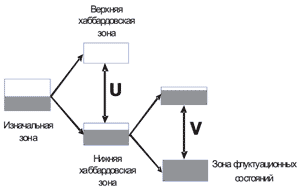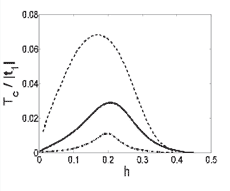Laboratory of Theoretical Physics
Laboratory Staff
Selected Publications
History

Research Focus
- Study of the physical properties of the materials with strong quantum fluctuations: high-temperature superconductors, heavy-fermion intermetallic compounds, quantum magnets, and substances with colossal magnetoresistance (led by Valerii V. Val’kov). We intensively develop and apply modern methods for theoretical investigations of the systems with strong electron correlations. For the first time, we developed the theory of a superconducting phase of strongly correlated fermions with regard to anomalous components of the force operator. We established the features of the spectral theorem for the spectral intensity of correlation functions in the atomic representation of the systems with strong electron correlations. We built the quantum theory of the two-dimensional frustrated antiferromagnet with the magnetoelastic coupling.
- Study of the wave propagation in media with regular and random inhomogeneities (led by Val’ter A. Ignatchenko). The new method for studying the effect of inhomogeneities on the wave spectrum in superlattices was developed. The wave spectrum of the superlattices with an arbitrary thickness of the interfaces between layers was investigated. It was demonstrated that this thickness can be measured by spectral methods. The theories of exchange narrowing the magnetic resonance line in an inhomogeneous ferromagnet and of bound magnetoelastic modes in superlattices have been developed.
Advanced developments
- With regard to the scattering on spin fluctuations, we developed the theory of a superconducting phase with the d-type symmetry of the order parameter, experimentally observed in cuprate oxides. We showed that in the description of the spin fluctuation scattering processes, an important role is played by the anomalous components of the force operator that were introduced by us for the first time. This yields the modification of the Gor’kov equations and significantly affects the calculated anomalous means in the Hubbard fermion subsystem.
- For the first time, we demonstrated that the interstitial Coulomb interaction in Mott--Hubbard dielectrics leads to the splitting of the lower Hubbard band into two subbands (Fig. 1) as soon as the characteristic value of this interaction becomes comparable with of exceeds the kinetic energy of the Hubbard fermions. It is important that the spectral intensity of the lower band (fluctuation state band) depends on the root-mean-square fluctuation of the occupation numbers and grows with the doping level.
- Within the effective model for the 2D Kondo lattice, we developed the theory of the superconducting phase of an ensemble of spin polarons. Taking into account the effective interactions between such quasi-particles, we built the phase diagram determining the region of implementation of the superconducting phase.
- For the real structure of the CuO2 plane of cuprate superconductors, we obtained the energy structure of nonlocal spin polarons and considered the Cooper instability in an ensemble of such Fermi quasi-particles. A nonlocal spin polaron forms due to the exchange interaction of the spin moment of an oxygen hole and the spin moments of two nearest copper ions. The scattering amplitude of nonlocal spin polarons in a Cooper channel calculated by a diagram technique revealed the strong correlation between the spin and charge degrees of freedom (Fig. 2).
 |
 |
| Fig. 1. Schematic of the splitting of the energy bands in a system with the strong electron correlations under the action of the one-site and interstitial Coulomb interactions. |
Fig. 2. Concentration dependences of TC for finite (solid curve) and zero (dashed curve) values of the magnetic correlators. |
- Using the periodic Anderson model in the limit of the strong electron correlations, we developed the theory of the superconducting state with the s-type symmetry of the order parameter. We obtained the exact representations of the Green’s function of the superconducting phase via normal and anomalous components of the mass and force operators. We demonstrated that in the description of the superconducting phase, a key role is played by the anomalous components of the force operator that reflect the spin fluctuation processes in a localized subsystem. In the one-loop approximation, these components were calculated from the solution of the infinite system of integral self-consistency equations for the superconducting phase. According to the numerical calculations, inclusion of the scattering on the spin fluctuations leads to renormalization of the critical temperature to the one observed in the experiment.
- Under the condition of the canted sublattices in a magnetic field, we developed the theory of antiferromagnetic rare-earth heavy-fermion intermetallides. Taking into account the rearrangement of the magnetic subsystem, we established the low-temperature features of electron specific heat of heavy-fermion antiferromagnets with the metal type of the ground state. The calculated temperature dependences of magnetization, specific heat, and the Sommerfeld constant in the vicinity of the point of the transition to the antiferromagnetic phase are in good agreement with the experimental data for heavy-fermion antiferromagnets PuGa3, Ce2Au2Cd, YbNiSi3, and PuPd5Al2.
- In cooperation with the researches of the Laboratory of Strong Magnetic Fields, we proposed the model of the Schottky centers in the CuOx chains of the YBa2Cu3O6+x compound. The model allowed us to explain the experimental features in the low-temperature specific heat in a magnetic field. We suggested that an increase in the oxygen concentration leads to the formation of single Cu2+ ions and five-ion Cu-O-Cu-O-Cu complexes whose energy structure is built with regard to the crystal field of the cubic symmetry with the orthorhombic addition, spin-orbit interaction, and splitting in a magnetic field.
- We studied the effect of the cross-correlations between 1D and 3D phase inhomogeneities on the spectral properties of waves in the superlattices. We showed that the positive cross-correlations partially reconstruct the band spectrum of the superlattices and reduce the wave damping.
- We investigated the effect of 2D phase inhomogeneities on the high-frequency susceptibility of the superlattice (multilayer structure). We found the pronounced asymmetry of peaks in the imaginary part of the Green’s functions that correspond to the odd band gap edges: the peak corresponding to the lower frequency shifts to the band center as the root-mean-square fluctuations of the 2D inhomogeneities grow from zero (bold solid curve in Fig. 3) to the maximum value (thin solid curve in Fig. 3), while the peak of a higher frequency broadens and sharply drops untill complete vanishing.

- We considered the effect of the cross-correlations between inhomogeneities of the Hamiltonian parameters on the spectrum and damping of the spin and elastic waves and established two regularities. In the first case, the positive cross-correlations lead to the larger modification of the dispersion law and the growth of the wave damping (Fig. 4a); in the second case, they result in the lowering of these characteristics. Correspondingly, the negative cross-correlations lead, in each case, to the opposite effects.
 |
| Fig. 4. Damping of (a) spin and (b) elastic modes. |
